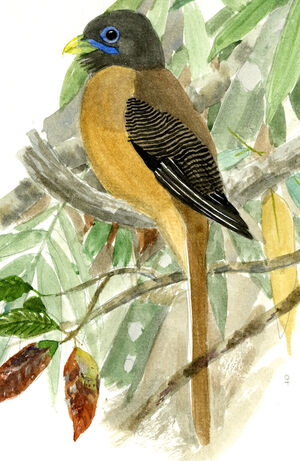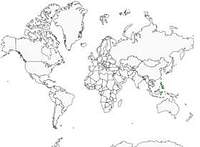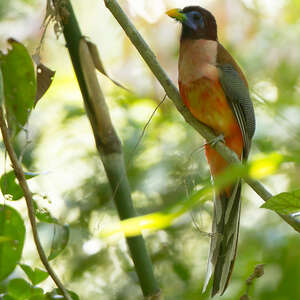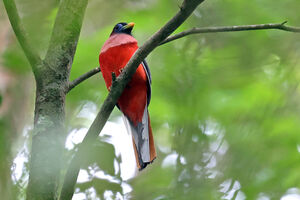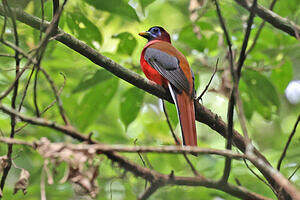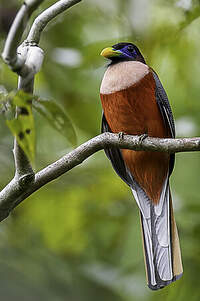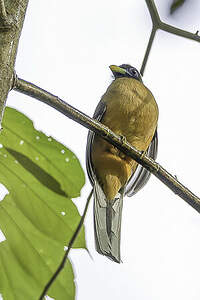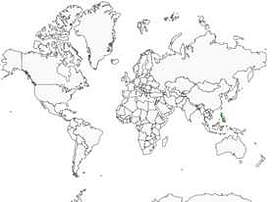Philippine Trogon
Harpactes ardens - Trogon des Philippines
Identification
The Philippine Trogon is obviously a resident of the archipelago of the same name, its scientific name is more evocative, Harpactes ardens or the Ardent Bandit, referring to the bright red color of the male's belly. The dimorphism is marked, the male has the base of the beak green with the tip tinted with a yellow point of the most beautiful effect, it is the only trogon to have this peculiarity. The forehead is black, the cap and the nape are dark brown, depending on the light, violet reflections appear on the throat and forehead, the bird has a large cobalt blue orbital circle surrounding the dark brown iris and in the extension of the beak a blue skin protuberance highlighting the eye. The chest is a beautiful pastel pink, between the chest and the bright red belly, a very light gray band appears, but is not always visible depending on individuals. The mantle, the back and the shoulder blades are brown with orange nuances, the black covers bear the distinctive mark of the majority of trogons: horizontal white vermiculations while the black remiges are clearly highlighted in white at the emarginations. The central rectrices are chestnut brown and barred with black at their extremity, the three pairs of external rectrices are white and have black marks in their center. The females have the head dark olive-brown, Madam wears the same large cobalt blue orbital circle extended by a blue skin protuberance, the beak remains yellow with a light green base, the mantle and the back are brown; the chest and the belly are golden yellow, the dark brown covers have beautiful chamois vermiculations, the white external rectrices have diffuse gray marks in their center. The tarsi are olive green. Five subspecies are recognized: ssp ardens ardens which gives its name to the species; ssp ardens linae with a more marked black throat and a larger beak, the female is similar to the ardens female; ssp ardens minor is smaller and has a pink chest tending towards red, the female is smaller; ssp ardens luzionensis has a very dark brown back, the cap is rather black and the beak is smaller, the female is darker on the back and the head is black; ssp ardens herberti has a reddish brown head and a pale red belly, the female is similar to the luzionensis female but the head is dark brown instead of black.
Subspecific information 5 subspecies
- Harpactes ardens ardens (Basilan, Dinagat and Mindanao. s Philippines.)
- Harpactes ardens herberti (ne Luzon. n Philippines.)
- Harpactes ardens luzoniensis (Luzon. except ne. , Marinduque and Catanduanes (n Philippines))
- Harpactes ardens minor (PolilloI.. n Philippines.)
- Harpactes ardens linae (Bohol, Leyte and Samar. c Philippines.)
Foreign names
- Trogon des Philippines,
- Trogón filipino,
- republicano-filipino,
- Philippinentrogon,
- fülöp-szigeteki malájtrogon,
- Filipijnse Trogon,
- Trogone delle Filippine,
- filippintrogon,
- Rosenbrysttrogon,
- dravčík filipínsky,
- trogon filipínský,
- Filippinsk Trogon,
- filippiinientrogoni,
- trogon de les Filipines,
- sędzioł filipiński,
- Филиппинский азиатский трогон,
- バラムネキヌバネドリ,
- 粉胸咬鹃,
- filippintrogon,
- 粉胸咬鵑,
Voice song and call
Habitat
The Philippine Trogon can almost exclusively be found in primary forests, particularly dipterocarp forests made up of very tall trees (teak included) that reach a height of 30 metres and more; while it can be spotted up to 2000 metres, it is more frequently seen between 200 and 600 metres and will normally avoid trees too covered in moss.
Behaviour character trait
Only sedentary.
Dietfeeding habits
Mainly an insectivore, in particular orthopterans and phasmids, it generally hunts insects perched on a branch. It adds variety to its diet with various fruits.
Reproduction nesting
Breeding period from March to May, juveniles are often observed from April to June. The Philippine Trogon digs its nest in an excavation of an old tree, often an old woodpecker nest at a height of 2 to 6 m. The clutch size is 2 to 3 eggs and the male is thought to have an important role in incubating the eggs; no other information is currently available on the incubation period, the feeding, and the raising of the chicks.
Geographic range
In the Philippines, the subspecies of the Philippine Trogon are distributed as follows: ssp ardens ardens in the south of the archipelago, in Mindanao, on the island of Dinagat to the northeast of Mindanao and on the island of Basilan to the southeast of Mindanao; ssp ardens linae in the province of Eastern Visayas on the island of Leyte and Samar and on the island of Bilaran to the north of Leyte, in Central Visayas on the island of Bohol; ssp ardens minor on the string of islands of Polillo a few miles east of Manila; ssp ardens luzionensis on the large island of Luzon (except northeast), on the island of Marinduque, South Tagalog province to the south of Manila and on the island of Catanduanes, Bicol province to the southeast of Luzon and finally ssp ardens herberti in the northeast of Luzon.
Threats - protection
IUCN conservation status
concern
in the Wild
threatened
evaluated
The IUCN, Birdlife and LC still classify the Philippine Trogon as a species of minor concern, but the first signs of decline are appearing: decreasing populations, high human demographic pressure, pollution and major exposure to climate disturbances. Explorers of the 19th century described this bird as very common on most of the archipelago, ssp. luzonensis is becoming rare on the island of Marinduque, ssp. linae is a victim of poaching on the island of Bohol and ssp. minor is only observed in the south of the island of Polillo. The awakening is likely to be abrupt for this magnificent harlequin-coloured trogon.
Sources of information
- IOC World Bird List (v14.2), Gill, F and D Donsker (Eds). 2024-04-18.
- A Natural history of the Trogonidae, Joseph M.Forshaw Albert Earl Gilbert
- Scientific Birds Names, James A.Jobling
- Vol. 6 - Handbook of the Birds of the World, Josep del Hoyo-Andrew Elliott-Jordi Sargatal
- xeno-canto, Sharing bird sounds from around the world,
- Avibase, Lepage Denis
- BirdLife International, BirdLife International
- HBW Alive,
- Oriental Bird Club,
- The internet Bird Collection,
- Wikipédia, Wikipedia, The Free Encyclopedia
Other sources of interest
 Specification sheet created on
04/08/2023 by Anne et Gabriel Leboff
Specification sheet created on
04/08/2023 by Anne et Gabriel LeboffTranslation by AI Oiseaux.net
© 1996-2025 Oiseaux.net
- Accipitriformes
- Aegotheliformes
- Anseriformes
- Apodiformes
- Apterygiformes
- Bucerotiformes
- Caprimulgiformes
- Cariamiformes
- Casuariiformes
- Charadriiformes
- Ciconiiformes
- Coliiformes
- Columbiformes
- Coraciiformes
- Cuculiformes
- Eurypygiformes
- Falconiformes
- Galliformes
- Gaviiformes
- Gruiformes
- Leptosomiformes
- Mesitornithiformes
- Musophagiformes
- Nyctibiiformes
- Opisthocomiformes
- Otidiformes
- Passeriformes
- Pelecaniformes
- Phaethontiformes
- Phoenicopteriformes
- Piciformes
- Podargiformes
- Podicipediformes
- Procellariiformes
- Psittaciformes
- Pterocliformes
- Rheiformes
- Sphenisciformes
- Steatornithiformes
- Strigiformes
- Struthioniformes
- Suliformes
- Tinamiformes
- Trogoniformes

